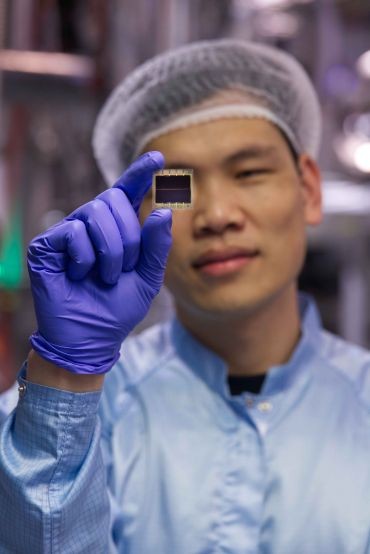
Scientists at Oxford University are coating a new solar power-generating material onto objects such as rucksacks, cars, and mobile phones.
The potential of this breakthrough means that increasing amounts of solar electricity could be generated without silicon-based solar panels.

The Oxford scientists’ new light-absorbing material is, for the first time, thin and flexible enough to apply to the surface of almost any building or common object. By stacking multiple light-absorbing layers into one solar cell (known as a multi-junction approach), a wider range of the light spectrum is harnessed, allowing more power to be generated from the same amount of sunlight.
This thin-film perovskite material has been independently certified by Japan’s National Institute of Advanced Industrial Science and Technology (AIST) to deliver over 27% energy efficiency. It matches the performance of traditional, single-layer silicon PV for the first time.
Dr Shuaifeng Hu (pictured), postdoctoral fellow at Oxford University Physics, said:
During just five years of experimenting with our stacking or multi-junction approach, we have raised power conversion efficiency from around 6% to over 27%, close to the limits of what single-layer photovoltaics can achieve today.
We believe that, over time, this approach could enable the photovoltaic devices to achieve far greater efficiencies, exceeding 45%.
The versatility of the new ultra-thin and flexible material is also key – at just over one micron thick, it’s almost 150 times thinner than a silicon wafer. Existing photovoltaics are generally applied to silicon panels, but this can be applied to almost any surface.
Dr Junke Wang, Marie Skłodowska Curie Actions postdoc fellow at Oxford University Physics, said:
We can envisage perovskite coatings being applied to broader types of surfaces to generate cheap solar power, such as the roofs of cars and buildings and even the backs of mobile phones. If more solar energy can be generated in this way, we can foresee less need in the longer term to use silicon panels or build more and more solar farms.
The 40 scientists working on photovoltaics at Oxford University Physics Department are led by Professor of Renewable Energy Henry Snaith. Their pioneering work in photovoltaics and especially the use of thin-film perovskite began around a decade ago.
Oxford PV, a UK company spun out of Oxford University Physics in 2010 by Snaith to commercialize perovskite photovoltaics, recently started large-scale manufacturing of perovskite photovoltaics at its factory in Brandenburg-an-der-Havel, near Berlin, Germany. It’s the world’s first volume manufacturing line for “perovskite-on-silicon” tandem solar cells.
Read more: Oxford sets a new world record for solar panel efficiency
To limit power outages and make your home more resilient, consider going solar with a battery storage system. In order to find a trusted, reliable solar installer near you that offers competitive pricing, check out EnergySage, a free service that makes it easy for you to go solar. They have hundreds of pre-vetted solar installers competing for your business, ensuring you get high-quality solutions and save 20-30% compared to going it alone. Plus, it’s free to use and you won’t get sales calls until you select an installer and you share your phone number with them.
Your personalized solar quotes are easy to compare online and you’ll get access to unbiased Energy Advisers to help you every step of the way. Get started here. –trusted affiliate link*
